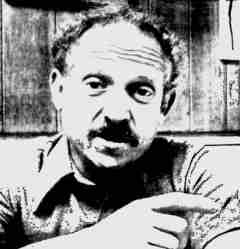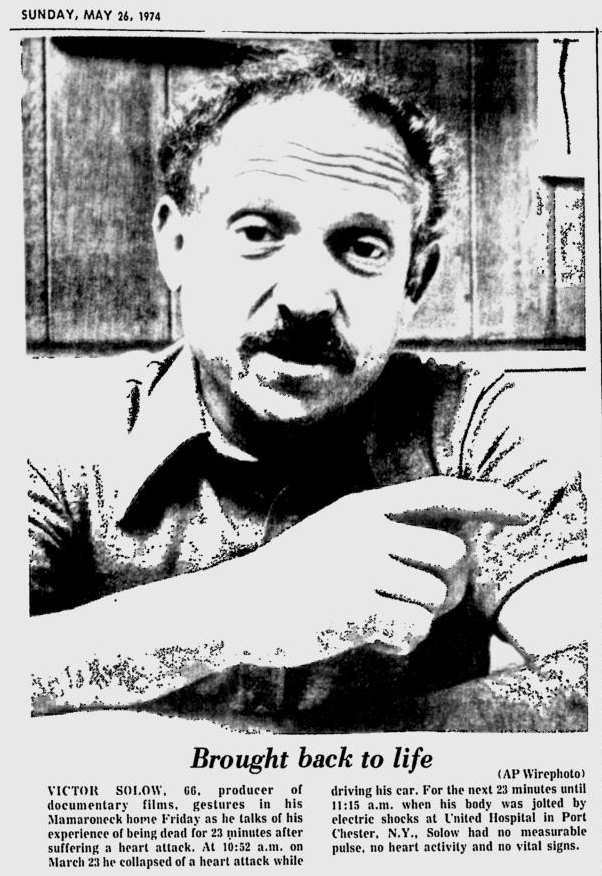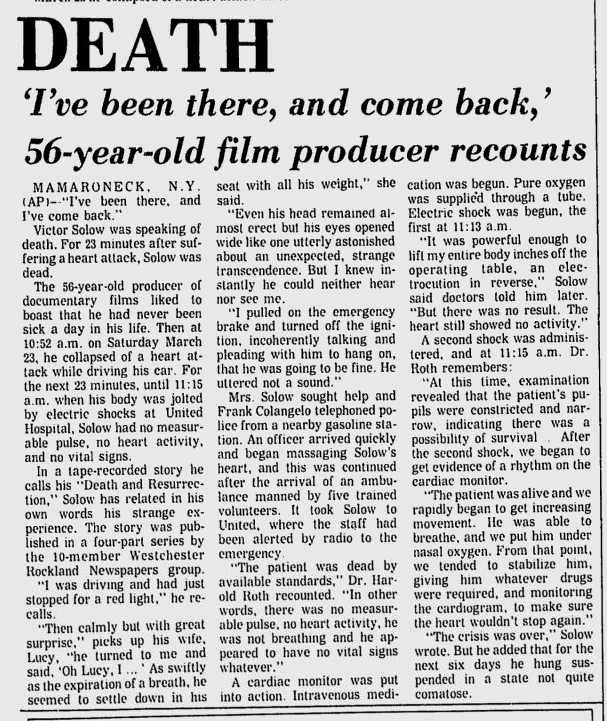SelfDefinition.Org
Afterlife Articles
Victor D. Solow
After-Death Experience

Brought Back to Life
Death: "I've been there, and come back," 56-year-old film producer recounts
Article Images
Scroll down for the text of the article.
A search of Newspapers.Com shows that this interview was nationally syndicated by AP and appears verbatim in several dozen newspapers. It condenses longer versions of the story authored by Solow himself, which appear Here and in a four-part series Here.
Article source: Daily News, Bowling Green, Kentucky. Sunday, May 26, 1974. (Link at Google News is mis-dated May 24, 1974)


Links to images full size: TOP and BOTTOM
Touch Back button to return.
Article Text
Brought back to life
VICTOR SOLOW, 56, producer of documentary films, gestures in his Mamaroneck home Friday as he talks of his experience of being dead for 23 minutes after suffering a heart attack. At 10:52 a.m. on March 23 he collapsed of a heart attack while driving his car. For the next 23 minutes until 11:13 a.m. when his body was jolted by electric shocks at Unlted Hospital in Port Chester. N.Y., Solow had no measurable pulse, no heart activity and no vital signs.
MAMARONECK. N.Y. (AP)
DEATH
"I've been there, and come back," 56-year-old film producer recounts
Victor Solow was speaking of death. For 23 minutes after suffering a heart attack, Solow was dead.
The 56-year-old producer of documentary films liked to boast that he had never been sick a day in his life. Then at 10:52 a.m. on Saturday March 23, he collapsed of a heart attack while driving his car. For the next 23 minutes, until 11:15 a.m. when his body was jolted by electric shocks at United Hospital, Solow had no mensurable pulse, no heart activity, and no vital signs.
In a tape-recorded story he calls his "Death and Resurrection", Solow has related in his own words his strange experience. The story was published in a four-part series by the 10-member Westchester Rockland Newspapers group. [See victor-solow-4-part-series.htm ]
"I was driving and had just stopped for a red light," he recalls.
"Then calmly but with great surprise," picks up his wife. Lucy, "he turned to me and said. 'Oh Lucy. I...' As swiftly as the expiration of a breath, he seemed to settle down in his seat with all his weight," she said.
"Even his head remained almost erect but his eyes opened wide like one utterly astonished about an unexpected, strange transcendence. But I knew instantly he could neither hear nor see me.
"I pulled on the emergency brake and turned off the ignition, incoherently talking and pleading with him to hang on, that he was going to be fine. He uttered not a sound."
Mrs Solow sought help and Frank Colangelo telephoned police from a nearby gasoline station. An officer arrived quickly and began massaging Solow's heart, and this was continued after the arrival of an ambulance manned by five trained volunteers. It took Solow to United, where the staff had been alerted by radio to the emergency.
"The patient was dead by available standards," Dr. Harold Roth recounted. "In other words, there was no measurable pulse, no heart activity, he was not breathing and he appeared to have no vital signs whatever."
A cardiac monitor was put into action. Intravenous medication was begun. Pure oxygen was supplied through a tube. Electric shock was begun, the first at 11:13 a.m.
"It was powerful enough to lift my entire body inches off the operating tabie, an electrocution in reverse," Solow said doctors told him later. "But there was no result. The heart still showed no activity."
A second shock was administered, and at 11:15 a.m. Dr. Roth remembers:
"At this time, examination revealed that the patient's pupils were constricted and narrow, indicating there was a possibility of survival. After the second stock, we began to get evidence of a rhythm on the cardiac monitor.
"The patient was alive and we rapidly began to get increasing movement. He was able to breathe, and we put him under nasal oxygen. From that point, we tended to stabilize him, giving him whatever drugs were required, and monitoring the cardiogram, to make sure the heart wouldn't stop again."
"The crisis was over." Solow wrote. But he added that for the next six days he hung suspended in a state not quite comatose.
[ end ]
Related articles in this section: